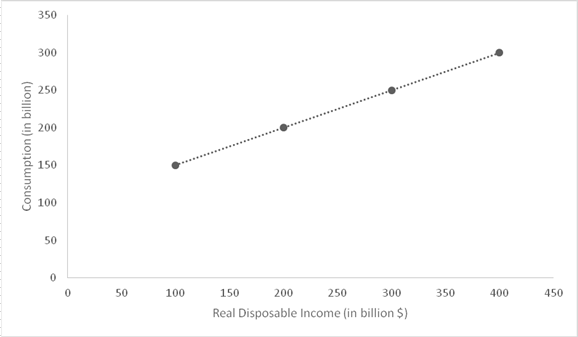
Sub- Part
A
Based on the data, Graphical representation of consumption function, with consumption spending on vertical axis and disposable income on horizontal axis.
Sub- Part
A
Explanation of Solution
(a) − Following graph shows the consumption function in an economy.

Sub- Part
Introduction: Consumption function represents the functional relationship between total consumption and gross
B
Based on the data, to find:
Slope, if consumption function is a straight line
B
Explanation of Solution
In case of a straight line, slope of the line remains constant or same everywhere along the line. So, if the consumption function is a straight line then its slope will remain same everywhere along it. The difference between two level of income and consumption will be constant. The slope of consumption function can be calculates as follows −



Thus, the slope of given consumption function is 0.5.
Sub- Part
Introduction: Consumption function represents the functional relationship between total consumption and gross national income. Consumer spending depends on three factors: disposable income (Yd), autonomous consumption (a), i.e. when income is zero, and induced income (b), i.e. the percentage of extra income that is spent. The formula for the same is C = a + b*Yd.
C
Based on the data,
Find the Savings at each level of income and the slope when the saving function is a straight line.
C
Explanation of Solution
If the saving function is a straight line then its slope will remain constant. Difference between two level of income and saving will remain constant along the saving function. As saving function is a straight line, change in saving and income would be the same. Thus, the slope of saving function would be:



| Real Disposable Income (in billion $) | Consumption Expenditure (in billion $) | Savings (in billion $) |
| 100 | 150 | -50 |
| 200 | 200 | 0 |
| 300 | 250 | 50 |
| 400 | 300 | 100 |
Introduction: Consumption function represents the functional relationship between total consumption and gross national income. Consumer spending depends on three factors: disposable income (Yd), autonomous consumption (a), i.e. when income is zero, and induced income (b), i.e. the percentage of extra income that is spent. The formula for the same is C = a + b*Yd.
Want to see more full solutions like this?
Chapter 9 Solutions
ECON: MACRO4 (with CourseMate, 1 term (6 months) Printed Access Card) (New, Engaging Titles from 4LTR Press)
- 1.12 Study the following diagram and answer the question that follows. Expenditures (billions of dollars per year) 3500 3000 2500 2000 1500 1000 500 Figure 9.1 45 500 1000 1500 2000 2500 3000 3500 Income (billions of dollars per year) At an income level of $2,000 billion, a) Consumption equals $1,500 billion. b) Saving equals $0. c) The MPC equals 0.80. d) There is dissaving.arrow_forwardGiven Table 12-6 below, fill in the values for saving. Assume taxes = $800. Table 12-6 National Income $11,400 11,800 12,200 12,600 Consumption $7,500 7,800 8,100 8,400 Use the editor to format your answer Savingarrow_forwardThe following table shows data for the economy before the decrease in saving. Suppose that the decrease in saving causes consumption to rise from $280 million to $320 million. Assume Say's law holds in this economy. Fill in the data for the economy after the decrease in saving. Before Saving Decrease After Saving Decrease Consumption (C) $280 million $320 million Investment (I) $200 million $ million Government Purchases (G) $250 million $ million Exports (EX) $500 million $500 million Imports (IM) $300 million $300 million As a result of the decrease in saving, total expenditures will .arrow_forward
- 3. Finally, think about the following applied situation: An economist wants to estimate a line that relates personal consumption C and disposable income I. The economist interviews a few households and obtains the following data: Income Consumption (thousands of dollars) (thousands of dollars) 20 18 18 13 27 21 36 27 37 26 45 36 50 39 c) What is the interpretation of the rate of change? Clearly state the units for the slope and write a sentence explaining what the rate of change tells us in this case.arrow_forwardAn economy's consumption function is depicted in the table below. Consumption (C) ($ billions) 100 199 298 Disposable Income (Yd) ($ billions) 0 110 220 330 440 550 397 496 595 W The economy's MPC is equal to: Round your final answer to 2 decimal places, if necessary. Do not enter a comma "," or a dollar sign ($) while entering your answer.arrow_forwardC= R60 million I= R280 million Goverment= R310 million C = 0.75 1. Calculate the Autonomous expenditure 2. Calculate the Equilibrium level of income. 3. Draw a graph to illustrate the Equilibriumarrow_forward
- Potential GDP| ' 45° C+1+(X-IM) 4,800 B 3,200 3,000 4,000 5,000 2. Use the graph above to answer the following questions: a. Calculate the MPC: b. What is the equilibrium value of GDP?_ Real Expenditure (billions of dollars per year)arrow_forwardDraw expenditure graph with information below C=360+0.6Y I=200million G=150millionarrow_forwardIn a simple economy (assume there are no taxes, thus Y is disposable income), the consumption function is C= 100 +0.75Y Investment is equal to 400. In this economy, equilibrium GDP is $ (Round your answer to the nearest dollar) 1.) Using the point drawing tool, on the graph to the right, indicate the real GDP point that you found above Label the point 'E' 2) Using the line drawing tool, carefully graph the consumption plus investment line Properly label your line Carefully follow the instructions above, and only draw the required objectsarrow_forward
- 3. Consumption function and non-income determinants The following graphs show an economy's initial position at point A along its consumption function (C). Suppose disposable income increases. On the graph, shift either the consumption curve or the initial point on the consumption function to show the impact of an increase in disposable income. (Note: In the scenario where the curve shifts, only shift the curve and do not adjust the position of the point.) ? REAL CONSUMPTION (Billions of dollars) C REAL DISPOSABLE INCOME (Billions of dollars) Now suppose that rising home values increase households' net wealth. C O A On the following graph, shift either the consumption curve or the initial point on the consumption function to show the impact of an increase in households' net wealth. (Note: In the scenario where the curve shifts, only shift the curve and do not adjust the position of the point.)arrow_forwardUse the figure below to answer the following questions. Household expenditure (thousands of dollars per year) 32- 24 16 00 8 16 24 32 40 Household income (thousands of dollars per year) Figure 1A.3.1 The slope of the line in Figure 1A.3.1 isarrow_forwardU.S. business inventories increase Business inventories in the United States rose 0.4% in July after no change in the prior month. An increase in inventories adds to gross domestic product while a decrease subtracts from it. Source: U.S. Department of Commerce, September 13, 2019 Explain why an increase in inventories adds to gross domestic product but why it matters whether an increase in inventories is planned or unplanned. A planned increase in inventories _______. A. decreases investment, which decreases equilibrium expenditure and real GDP B. increases investment, which increases equilibrium expenditure and real GDP C. shifts the AE curve upward, so firms decrease production and real GDP decreases to reach equilibrium expenditure D. shifts the AE curve downward, so firms decrease production and real GDP decreases E. increases consumption expenditure, which increases equilibrium expenditure and real GDP An unplanned increase…arrow_forward


 Essentials of Economics (MindTap Course List)EconomicsISBN:9781337091992Author:N. Gregory MankiwPublisher:Cengage Learning
Essentials of Economics (MindTap Course List)EconomicsISBN:9781337091992Author:N. Gregory MankiwPublisher:Cengage Learning Brief Principles of Macroeconomics (MindTap Cours...EconomicsISBN:9781337091985Author:N. Gregory MankiwPublisher:Cengage Learning
Brief Principles of Macroeconomics (MindTap Cours...EconomicsISBN:9781337091985Author:N. Gregory MankiwPublisher:Cengage Learning



